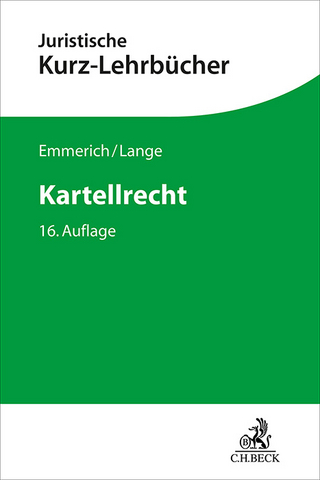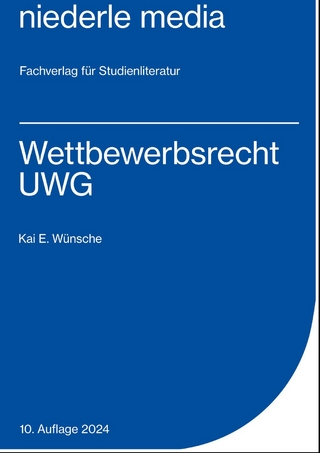
Antitrust Law
An Analysis of Antitrust Principles and Their Application
Seiten
2020
Aspen Publishers Inc.,U.S. (Verlag)
978-0-7355-6428-2 (ISBN)
Aspen Publishers Inc.,U.S. (Verlag)
978-0-7355-6428-2 (ISBN)
Recently cited by the Tenth Circuit in Kay Electric Cooperative vs. City of Newkirk and#8220;with its usual care Professor Areeda and Hovenkampand#8217;s treatise traces all these warps and weftsand#8221; in analyzing a municipalityand#8217;s antitrust immunity in light of state authorizing legislation.
The authoritative antitrust resource covering mergers and acquisitions, intellectual property and antitrust, predatory pricing, antitrust issues in healthcare, media, and other areas, monopolizing conduct, andquot;substantialandquot; market power, market share and buyer concentration, interlocking directors, refusals to deal, territorial customer limitation, product tying, contractual arbitration provisions; widely cited by the courts, including more than 100 citations by the Supreme Court and FTC combined. By Phillip E. Areeda, Herbert Hovenkamp
The authority of Areeda and Hovenkamp's Antitrust Law is second to none. It has been cited more than 50 times by the Supreme Court, more than 50 times by the FTC, and more than 1,050 times by the federal courts. Most recently it was cited by the Supreme Court in American Needle, Inc. v. National Football League. No other source gives you all the law to avoid antitrust liability as you:
Plan marketing strategies and develop pricing policies
Structure mergers and acquisitions with attention to potential antitrust consequences
Prove - or defend against - antitrust injury, monopolization, conspiracy, tying, and other allegation
Among the real-world examples and proven strategies you can apply directly to your own cases, you'll find clear discussions of
Intellectual property and antitrust
Predatory pricing
Antitrust issues in healthcare, media, and other areas
Monopolizing conduct
andquot;Substantialandquot; market power
Market share and buyer concentration
Interlocking directors
Refusals to deal
Territorial customer limitation
Product tying
Contractual arbitration provisions
Plus in-depth examination of thousands of cases
Antitrust Law is updated twice per year. A Cumulative Supplement is issued in April, and new volumes (Fourth Edition volumes starting in 2013) are issued in September. Highlights for the 2014 Supplement include:
Complete update of antitrust and#8220;state actionand#8221; cases, including the Supreme Court's Phoebe Putney decision and its aftermath, plus the litigation in the North Carolina Dental teeth whitening case. See Chapter 2, and#182;227.
Completely updated section on the law of antitrust class actions, including the Supreme Court's Comcast decision on the amount of common evidence of causation and harm required, and the Optronics decision on whether state Attorney General parens patriae actions qualify as class actions or and#8220;mass actionsand#8221; for purposes of the Class Action Fairness Act . See Chapter 3, and#182;331.
Updated coverage of Supreme Court treatment of agreements requiring the arbitration of antitrust claims, including prohibitions on class-action treatment. See Chapter 3, and#182;311.
Updates on the debate over the extent to which a relevant market must be proven in rule of reason antitrust actions and merger cases, or whether market power can be established by other means. See Chapter 15, and#182;1508.
Updates on most-favored-nation clauses (MFNs), discounting practices including market share discounts, patent exclusion practices, Standards-Essential Patents (SEPs) and Fair, Reasonable and Non-Discriminatory (FRAND) royalty commitments. See Chapter 18, and#182;1807b1 and Chapter 20, and#182;2022f.
All de
The authoritative antitrust resource covering mergers and acquisitions, intellectual property and antitrust, predatory pricing, antitrust issues in healthcare, media, and other areas, monopolizing conduct, andquot;substantialandquot; market power, market share and buyer concentration, interlocking directors, refusals to deal, territorial customer limitation, product tying, contractual arbitration provisions; widely cited by the courts, including more than 100 citations by the Supreme Court and FTC combined. By Phillip E. Areeda, Herbert Hovenkamp
The authority of Areeda and Hovenkamp's Antitrust Law is second to none. It has been cited more than 50 times by the Supreme Court, more than 50 times by the FTC, and more than 1,050 times by the federal courts. Most recently it was cited by the Supreme Court in American Needle, Inc. v. National Football League. No other source gives you all the law to avoid antitrust liability as you:
Plan marketing strategies and develop pricing policies
Structure mergers and acquisitions with attention to potential antitrust consequences
Prove - or defend against - antitrust injury, monopolization, conspiracy, tying, and other allegation
Among the real-world examples and proven strategies you can apply directly to your own cases, you'll find clear discussions of
Intellectual property and antitrust
Predatory pricing
Antitrust issues in healthcare, media, and other areas
Monopolizing conduct
andquot;Substantialandquot; market power
Market share and buyer concentration
Interlocking directors
Refusals to deal
Territorial customer limitation
Product tying
Contractual arbitration provisions
Plus in-depth examination of thousands of cases
Antitrust Law is updated twice per year. A Cumulative Supplement is issued in April, and new volumes (Fourth Edition volumes starting in 2013) are issued in September. Highlights for the 2014 Supplement include:
Complete update of antitrust and#8220;state actionand#8221; cases, including the Supreme Court's Phoebe Putney decision and its aftermath, plus the litigation in the North Carolina Dental teeth whitening case. See Chapter 2, and#182;227.
Completely updated section on the law of antitrust class actions, including the Supreme Court's Comcast decision on the amount of common evidence of causation and harm required, and the Optronics decision on whether state Attorney General parens patriae actions qualify as class actions or and#8220;mass actionsand#8221; for purposes of the Class Action Fairness Act . See Chapter 3, and#182;331.
Updated coverage of Supreme Court treatment of agreements requiring the arbitration of antitrust claims, including prohibitions on class-action treatment. See Chapter 3, and#182;311.
Updates on the debate over the extent to which a relevant market must be proven in rule of reason antitrust actions and merger cases, or whether market power can be established by other means. See Chapter 15, and#182;1508.
Updates on most-favored-nation clauses (MFNs), discounting practices including market share discounts, patent exclusion practices, Standards-Essential Patents (SEPs) and Fair, Reasonable and Non-Discriminatory (FRAND) royalty commitments. See Chapter 18, and#182;1807b1 and Chapter 20, and#182;2022f.
All de
| Erscheint lt. Verlag | 23.9.2020 |
|---|---|
| Reihe/Serie | Supplemented Twice Annually ; 19 |
| Verlagsort | Gaithersburg, MD |
| Sprache | englisch |
| Maße | 373 x 493 mm |
| Themenwelt | Schulbuch / Wörterbuch ► Lexikon / Chroniken |
| Recht / Steuern ► EU / Internationales Recht | |
| Recht / Steuern ► Wirtschaftsrecht ► Wettbewerbsrecht | |
| ISBN-10 | 0-7355-6428-0 / 0735564280 |
| ISBN-13 | 978-0-7355-6428-2 / 9780735564282 |
| Zustand | Neuware |
| Haben Sie eine Frage zum Produkt? |
Mehr entdecken
aus dem Bereich
aus dem Bereich
mit Preisangabenverordnung
Buch | Hardcover (2023)
C.H.Beck (Verlag)
139,00 €


